ALBERTO LEVI GALLERY presents... HUNTING AND GATHERING: China, Tibet, and East Turkestan 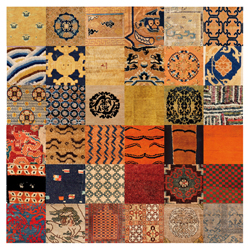
| The role of the antique rug dealer has changed dramatically over the last few years. With the advent of the internet many of the transactions now take place online, ranging from emails to eBay to even prestigious auction houses. The dealer and his gallery is often merely a point of transit and is destined to become obsolete.
‘Hunting and Gathering’ is a series of yearly web and gallery exhibitions aiming at restoring the fundamental role of the dealer. Borrowing the term from Archaeology, where it is used to describe the human mode of subsistence since the Paleolithic, it depicts what we dealers really do best - travel the world, not only virtually, hunting for the best pieces (which are more often than not hidden in some corner of the world and not available online) and putting them aside waiting for the best moment to present them to the market. The now ‘older’ generation of merchants had this as its modus operandi - think of all their beautiful yearly publications containing a selection of their recent acquisitions. Our main asset is the gigantic mental database that comes with years of hunting and it’s an invaluable experience equal to the hours spent in the operating room by a neurosurgeon. The downside of social media is that everyone can self proclaim himself as an authority on a subject. Here instead we offer documentary proof of our knowledge and comittment to our profession.
Each of these yearly exhibitions will be distinguished by a specific theme. This inaugural edition is dedicated to the weavings of China, Tibet and East Turkestan, which has been one of my focuses during the last few years. Each piece is photographed front and back and can be studied in detail by means of a zoom function. All the captions will feature a structural analysis, a condition report and a general description, indicating also the provenance. The price will be listed in every case. The aim is that of combining the traditional role of the dealer with modern technology and with the complete transparency that contemporary dealership entails. |

| 1. Fragment with tiger and leopard pelt pattern
Beijing
Northern China
Ming Dynasty
16th Century
120 x 20 cm (47 x 8 in.) | Knot count: | 5 H x 4 V = 20 kpsi |
| Colours: | light yellow, dark brown (2) |
| Condition: | fragmentary with the four sides sewn under and originally conserved with a light blue cotton fabric. Browns are partially corroded. |
| Notes: | The weave and handle of this fragment is typical of the chunky carpets with square knots dated to the Ming period and attributed to the Imperial looms of Beijing (see for example 2-4 and 6). To my knowledge it is the oldest pile rug with the tiger (and leopard) pelt pattern. Also the treatment of the design is quite similar to the way it appears on Ming silk velvets. It was retrieved in Inner Mongolia. |
Glanz der Himmelssohne - Kaiserlische Teppiche Aus China 1400-1750, plates |
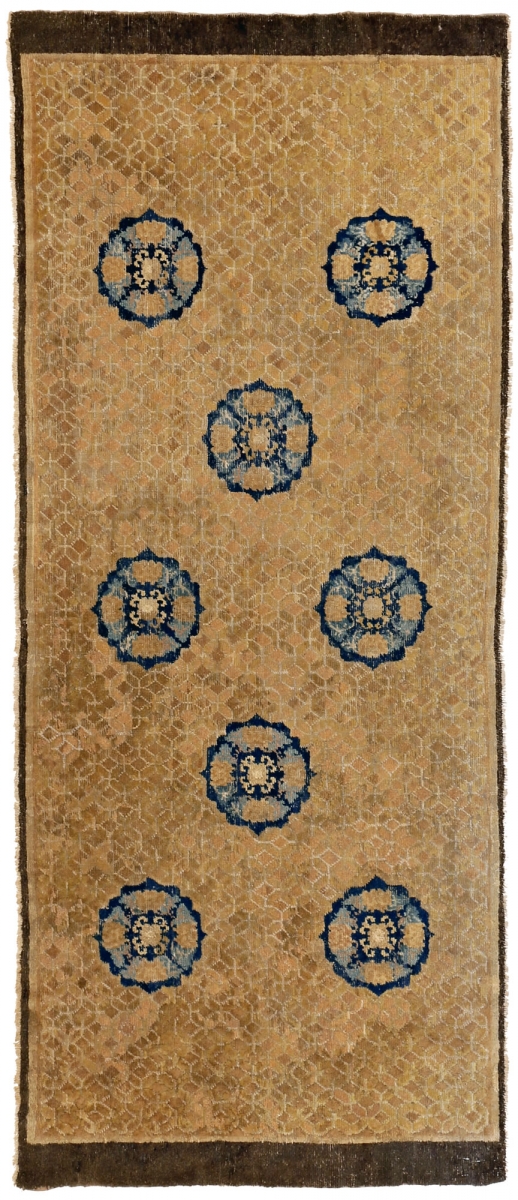
| 2.
Dais cover with eight lotus flower medallions
Ningxia
Northern China
Qing Dynasty
Kangxi period (1662-1722)
310 x 128 cm (122 x 50.5 in.)
| Knot count: | 10 H x 5 V = 50 kpsi |
| Colours: | light yellow, dark blue, light blue, pale rose, brown, ivory (6) |
| Condition: | scattered areas of repiling and reweaving. Partial end borders. |
| Notes: | Deacquisitioned many years ago from a small museum in midwest America, this carpet has the rather peculiar feature of being woven along the horizontal axis. The polylobal shape of the medallions is an indication of age and reminds us of the shape of the large cartouche medallions like the on the lion-dog fragment present in this exhibition. The format indicates that it was used to cover the raised platform dedicated to the reception of important guests, also known as the kang. |
|

| 3.
Meditation runner with stylised clouds
Ningxia
Northern China
Qing Dynasty
Kangxi period (1662-1722)
312 x 75 cm (123 x 29.5 in.)
| Knot count: | 5 H x 5 V = 25 kpsi |
| Colours: | angel skin rose, light yellow, light blue, dark brown, ivory (5) |
| Condition: | very good pile overall. Some corrosion to the browns. |
| Notes: | Composed of square seating mats, this rare monastic runner still conserves traces of the original red logwood dye for the background. The weave is slightly coarser than usual and the wool has a feel which we normally associate with the weavings of Inner Mongolia. This type of runner is typically found in Tibet in fragmentary condition, of which we know a few examples in the literature. The exclusive use of light blue corroborates my theory of it being a signature colour for rugs commisioned for the Tibetan monasteries. |
|
 | 4.
Fragment of a lion-dog medallion and scrolling flowers field carpet
Ningxia
Northern China
Qing Dynasty
Kangxi period (1662-1722)
260 x 70 cm (102.5 x 27.5 in.)
| Colours: | light yellow, dark blue, light blue, pale rose, tan, brown, ivory (7) |
| Condition: | a fragment of the left side of the carpet, missing the top border and a small section of the medallion. Areas of moth damage, wear and stains. Professionally mounted on a dark blue cotton fabric stretched over a thick layer white wool. |
| Notes: | Sourced in Tibet, this fragment belongs to a group of five other pieces discussed by Michael Franses in his superb monograph (Classical Chinese Carpets I - Lion-dogs, Hundred Antiques, London 2000, p. 38). The abundant use of light blue wool appears to me as a distinguishing feature for rugs commissioned for the Tibetan market. Also this type of fragmentation (cut exactly in half) is typical of the early Chinese carpets found in Tibet, as if it was divided in two by the heirs. |
|
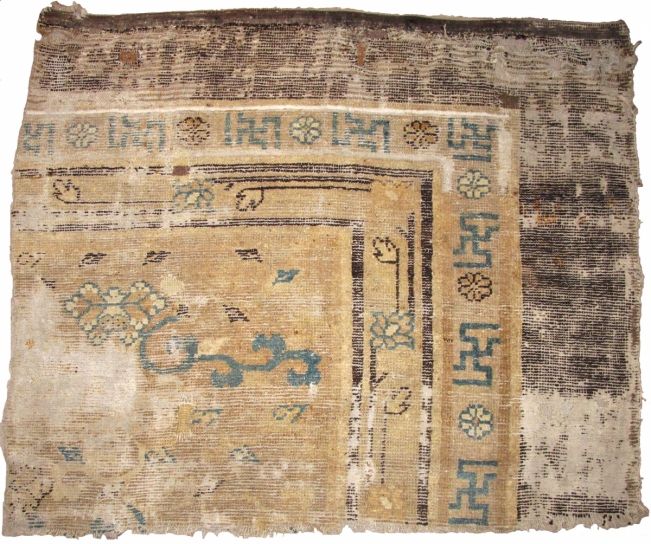 | 5.
Fragment of a carpet with lotus flowers
Inner Mongolia/Northern China
Qing Dynasty
Kangxi period (1662-1722)
145 x 122 cm (57 x 48 in.)
| Knot count: | 5 H x 5 V = 25 kpsi |
| Colours: | light blue, light yellow, taupe, dark brown, ivory(5) |
| Condition: | fragmentary, with areas of wear and deep corrosion in the dark brown. |
| Notes: | A fragment of what must have been a large Imperial carpet, distinguished by a large scale allover pattern of lotus flowers. The weave is of a type we would normally associate with Mongolia and so is the abundant use of a dark corrosive brown, especially in the particularly wide outer border. The innermost guard stripe has a pattern that we see on Ming carpets. There is the added peculiarity of a row of knots in cotton tied across a single warp. |
|
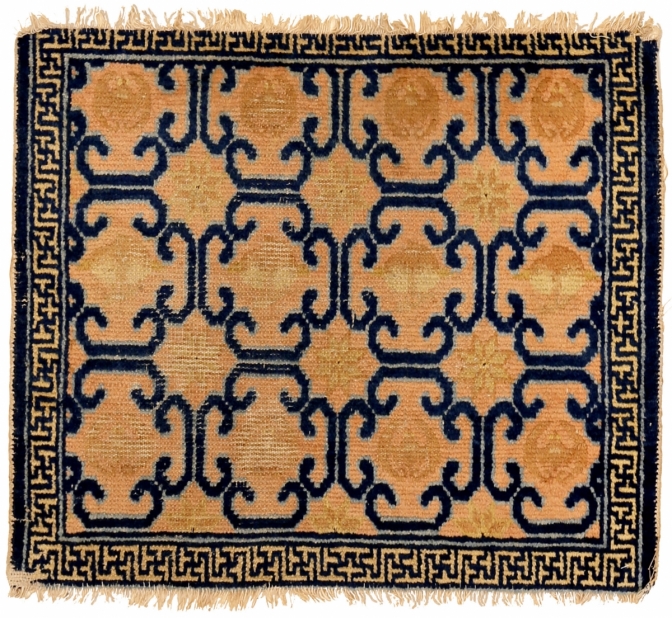 | 6.
Seating mat with longevity pattern
Ningxia
Northern China
Qing Dynasty
Kangxi period (1662-1722)
70 x 60 cm (27.5 x 23.5 in.)
| Knot count: | 7 H x 6 V = 42 kpsi |
| Colours: | rose, dark blue, light blue, light yellow, tan (5) |
| Condition: | scattered areas of wear. Missing outer guard stripe at lower end and part of the border at the upper end. |
| Notes: | The angular drawing of the longevity pattern coupled with the austerity of the greek fret border are characteristic features for seating mats dating to the earliest phase of the Qing dynasty. These often do not display the typical corroded brown outer border. This piece surfaced mysteriously in northern India. |
|
 | 7.
Imperial carpet border fragment with ‘standing water’ pattern
Ningxia
Northern China
Qing Dynasty
Kangxi period (1662-1722)
255 x 28 cm (100.5 x 71 in.)
| Knot count: | 6 H x 5 V = 30 kpsi |
| Colours: | dark blue, medium blue, light blue, gold yellow, brown, ivory (6) |
| Condition: | fragmentary with some areas of wear, a small hole and a larger one stabilised with a patch from the same border. Old conservation of the left side with a fabric acting as selvedge. |
| Notes: | A fragment of a large Imperial carpet with the ‘standing water’ design developing along the left vertical axis. We know this pattern from a carpet once in the Hall of Supreme Harmony in the Forbidden Palace of Beijing (see Glanz der Himmelssohne - Kaiserlische Teppiche Aus China 1400-1750, plate 4, p. 63) although its closest comparable is the Pine carpet with mountains, waves and lotus flowers (see Glanz, plate 32, p. 108). First hunted in Lhasa, this piece is published in K. de Jong Dragon & Horse - Saddle Rugs and Other Horse Tack from China and Beyond, Hong Kong 2013, plate 6.18, p. 82. |
|
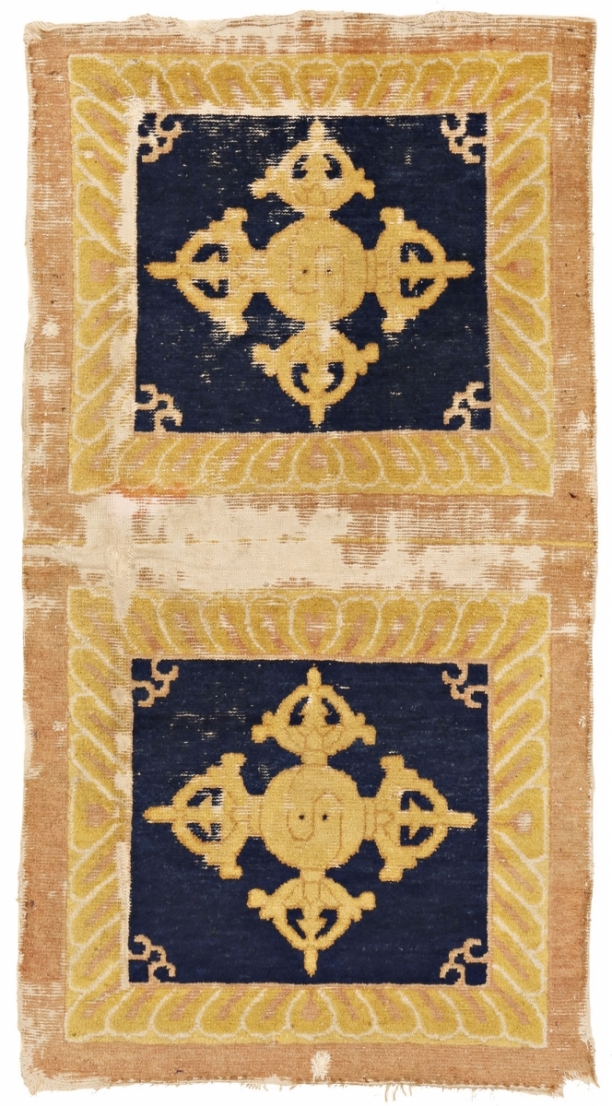 | 8.
Rug with double dorjè
Ningxia
Northern China
Circa 1730
150 x 79 cm (59 x 31 in.)
| Knot count: | 6 H x 6 V = 36 kpsi |
| Colours: | dark blue, rose red, salmon pink, lemon yellow, ivory (5) |
| Condition: | area of localised wear, with severe wear at the center. A few scattered holes that need conservation. A stain in the central/left area. Possibly a fragment of a longer rug. |
| Notes: | Most certainly woven for a Tibetan monastery, this rug is composed of two squares each contaning the double dorjè motif (also known as ‘crossed vajra’), which is the Buddhist symbol for a thunderbolt, protecting against evil. The spacing of the pattern, the quality of the weaving and the colour juxtaposition remind me of the refined carpets of the Yongzheng period (1723-1735). |
|
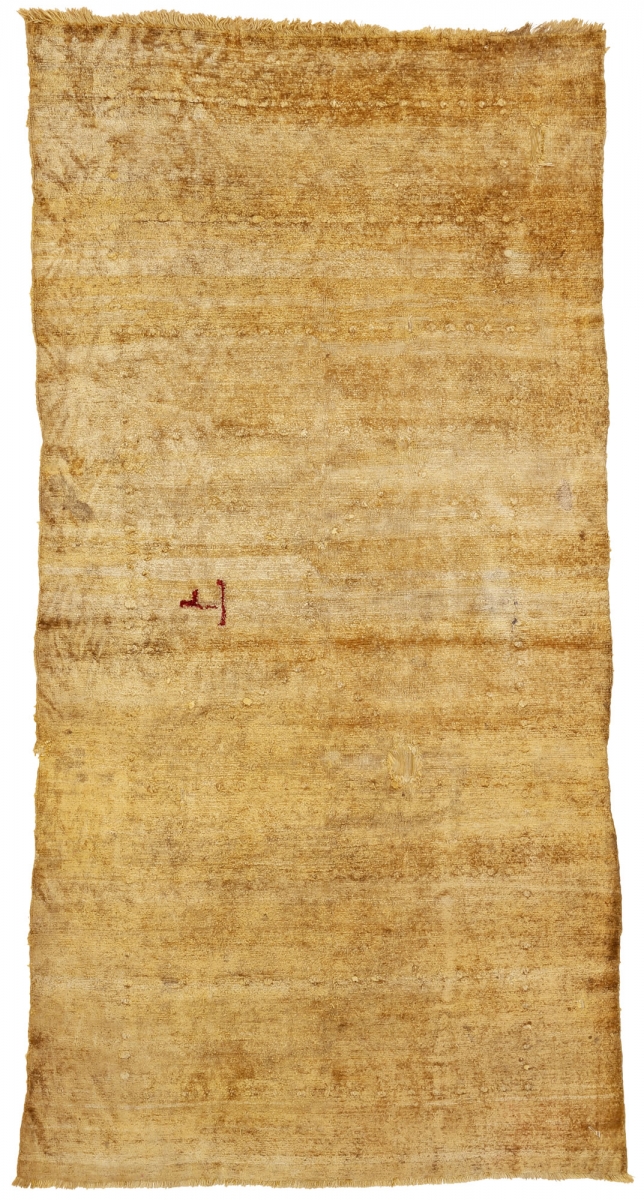 | 9.
Silk rug with inscription
China
Before 1700
178 x 90 cm (70 x 35.5 in.)
| Knot count: | 16 H x 9 V = 144 kpsi |
| Colours: | gold yellow, red (2) |
| Condition: | good pile overall with a few localised areas of wear and associated holes, all of which need conservation. A stain on the upper/middle right hand side. Original sides and ends. |
| Notes: | What is this mysterious rug, unearthed in Tibet in the mid Nineties? Also my friend Edoardo Concaro couldn’t really answer this question when he wrote the caption to this piece in the ‘Sovrani Tappeti ‘ exhibition catalogue. The tone-on-tone compartment pattern created by using tufts of silk pile (and hardly noticeable on a digital image) makes me think of multi-niche rugs or ‘safs’. The red inscription apparently means something associated to the act of elevating oneself. The use of imperial yellow silk suggests that it was woven for a very high ranked individual. |
| Published: | E. Concaro, A. Levi, Sovrani Tappeti, Milano 1999, plate 143, p. 166. |
|
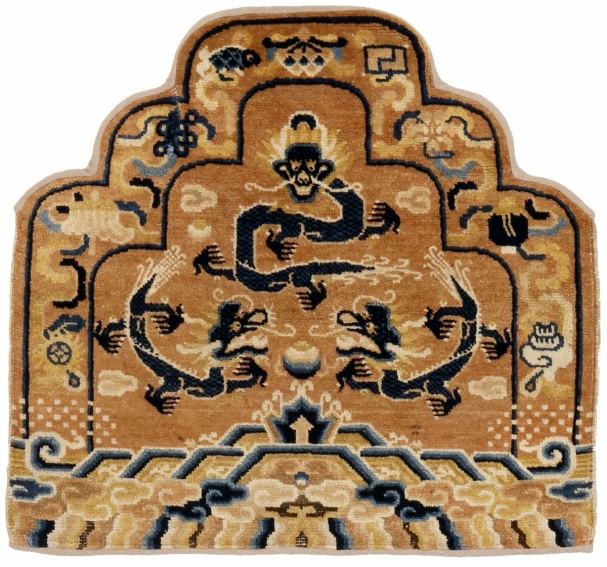 | 10.
Throne back cover with dragons chasing a flaming pearl
Ningxia
Northern China
Qing Dynasty
Circa 1830
75 x 70 cm (29.5 x 27.5 in.)
| Knot count: | 8 H x 9 V = 72 kpsi |
| Colours: | rose red, soft pink, dark blue, medium blue, light blue, lemon yellow, light yellow, dark brown, ivory (9) |
| Condition: | very good. Full pile overall, with original sides. Arch and lower end are bound in a beige fabric. There is a small stitched tear (7 cm/3 inches long) on the left hand shoulder. |
| Notes: | Judging by the care in the choice of wool, which is always of the finest type, the fine knotting and the use of a variegated palette often composed of many shades of the same colour one can postulate that these throne back covers were indeed items great prestige. The pattern here is composed of three dragons, symbols of power, chasing the flaming pearl, symbolising purity. The ascending border also contain a plethora of auspicious symbols. The rose red wool of the background is most probably dyed with logwood. |
|
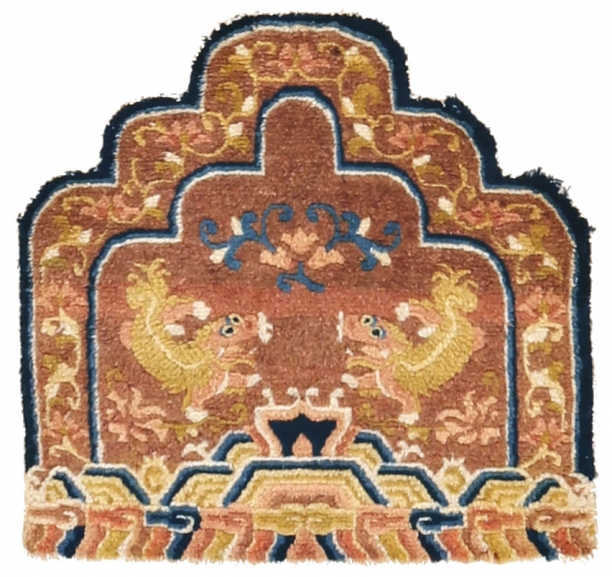 | 11.
Throne back cover with lion dogs
Ningxia
Northern China
Qing Dynasty
Circa 1800
67 x 65 cm (26.5 x 25.5 in.)
| Knot count: | 5 H x 5 V = 25 kpsi |
| Colours: | rose red, coral, salmon pink, dark blue, light blue, lemon yellow, light yellow, ivory (8) |
| Condition: | excellent. Full silky pile with original selvedges. |
| Notes: | A true gem distinguished by a plethora of shades of red, blue and yellow depicting a pair of superbly drawn lion dogs, auspicious symbols of protection and power, flanking a lotus flower with tendrils, symbol of purity. The rose red wool of the background is most probably dyed with logwood. |
|
 | 12.
Pillar cover with Ming pattern
Peking
Northern China
Circa 1900
385 x 48 cm (151.5 x 19 in.)
| Knot count: | 7 H x 7 V = 49 kpsi |
| Colours: | dark blue, medium blue, peach, light pink, bronze, light yellow, brown, ivory (8) |
| Condition: | excellent, full silky wool pile overall with original sides and ends. |
| Notes: | A very unusual long and narrow pillar rug, decorated by large lotus flowers with tracery in a manner reminiscent of Ming period weavings. I have seen three other examples of this type, all of which fragmentary (one is published in K.T. Darchen,Secrets of Tibetan Weaving, Hong Kong 2012, p. 92). These were most probably commissioned at the turn of the century for a specific monastery in Tibet. |
|
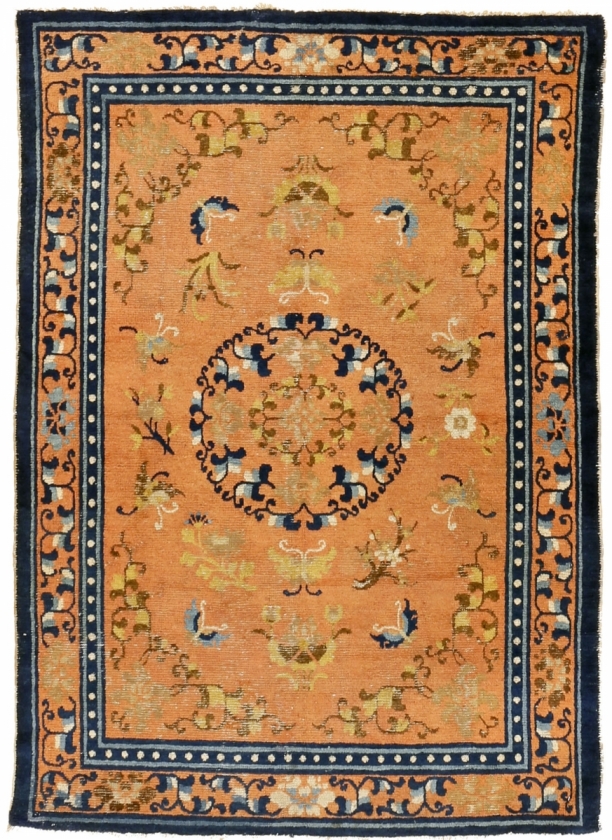 | 13.
Rug with floral medallion and butterflies
Ningxia
Northern China
Yongzheng period (1723-1735)
185 x 127 cm (73 x 50 in.)
| Knot count: | 7 H x 5 V = 35 kpsi |
| Colours: | rose, dark blue, light blue, tobacco brown, light green, ivory (6) |
| Condition: | medium to good pile overall with minor, scattered areas of repiling. The right hand selvedge is original. |
| Notes: | Characterised by the delicate drawing which distinguishes the weavings of the short and noble Yongzheng period, it has a beautifully drawn round medallion composed of conjoined lotus flowers, surrounded by butterflies and other floral motifs of unique gracefulness. |
|
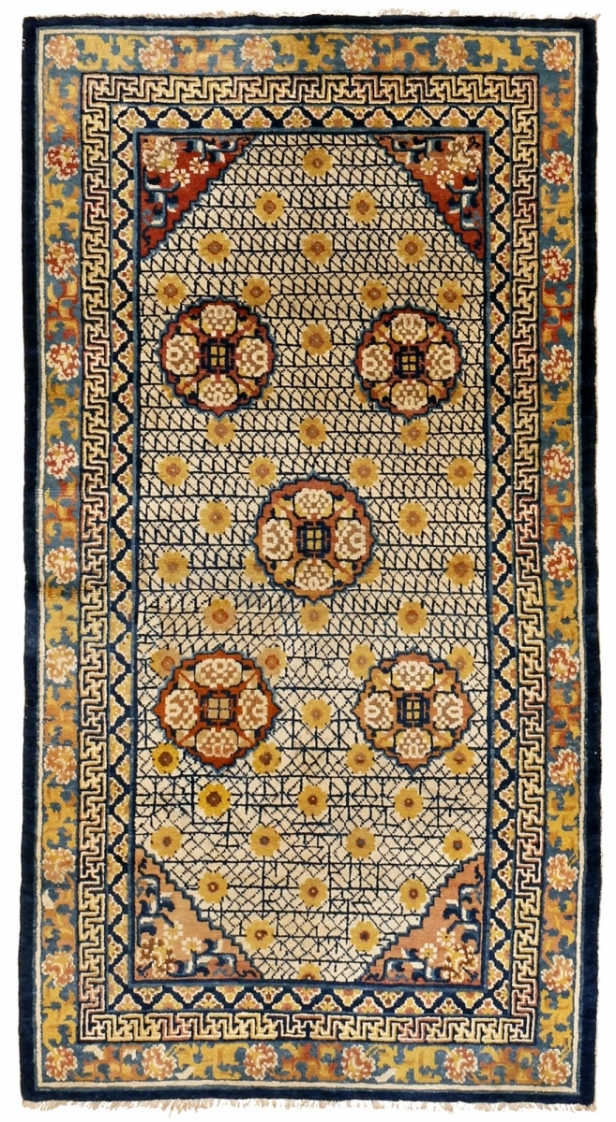 | 14.
Rug with cracked ice design
Ningxia
Circa 1870
210 x 110 cm (83 x 43.5 in.)
| Knot count: | 7 H x 7 V = 49 kpsi |
| Colours: | dark blue, light blue, rose red, lemon yellow, ivory (5) |
| Condition: | excellent, full lush pile with original sides and ends. |
| Notes: | Formerly in the Arthur M. Sackler collection, this fine ivory ground rug shows the so-called ‘cracked ice’ pattern in the background on which float five lotus flower roundels arranged in a quincunxial fashion, surrounded by an array of yellow eight-petaled rosettes. The red is most probably obtained from logwood. |
|
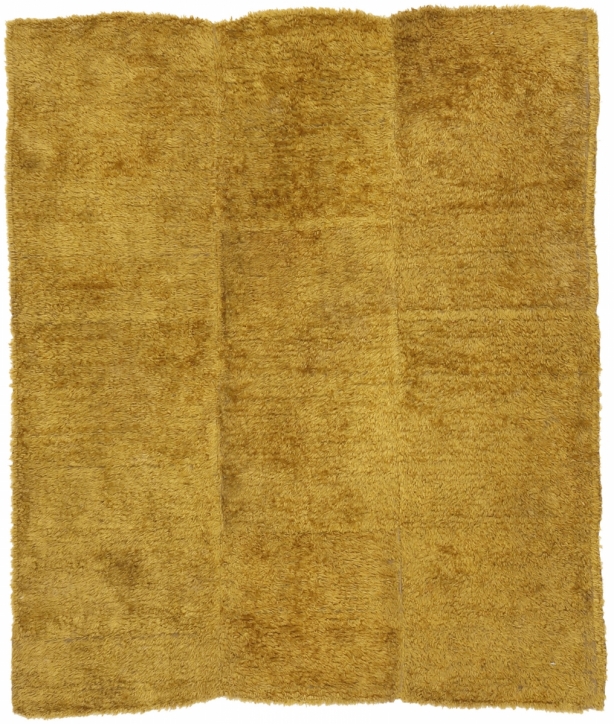 | 15.
Silk tsukdruk cover
Tibet
Circa 1900 or earlier
104 x 93 cm (41 x 36 in.)
| Notes: | A unique and intriguing piece, originally sourced in Tibet, consisting of three panels joined together, each made up of two or three smaller panels. The exclusive use of yellow silk suggests that it had been commissioned for a high-ranking Lama. |
|
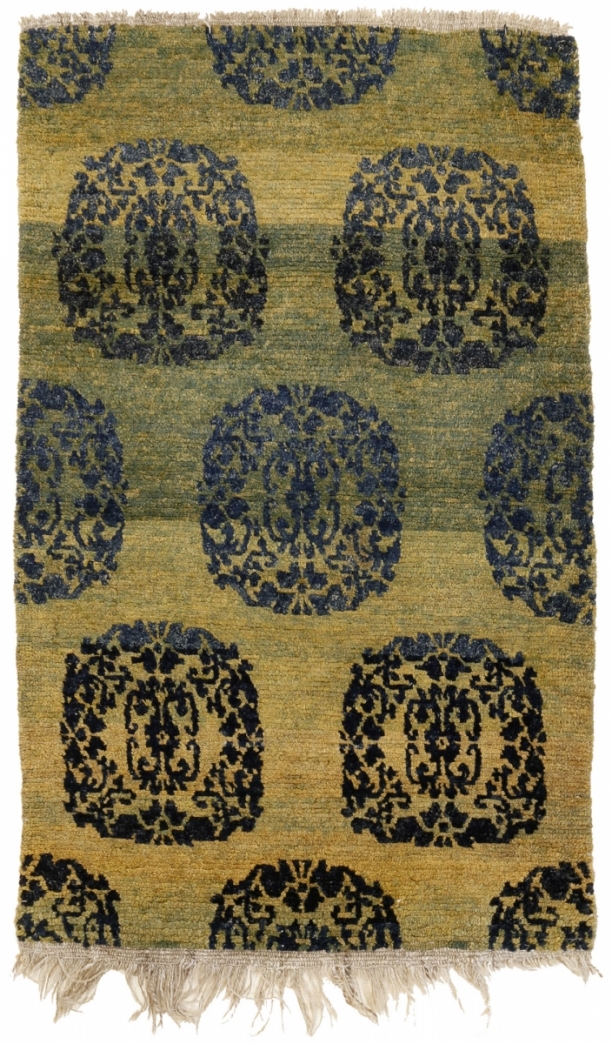 | 16.
Khaden with silk brocade pattern
Tibet
Circa 1880
160 x 93 cm (63 x 36.5 cm)
| Knot count: | 8 H x 4 V = 32 kpsi |
| Colours: | sea green, dark blue, medium blue (3) |
| Condition: | excellent. Full lush pile with original sides and ends. |
| Notes: | Distinguished by the so-called Gyantse weave, composed of thick squarish knots, this antique Tibetan rug is characterised by a luscious sea green background embellished by an infinite repeat pattern of large roundels composed of conjoined lotus flowers, typical of Chinese silk brocades. The silky quality of the Himalayan wool coupled with the excellent condition place this khaden at the pinnacle of the Tibetan weaving tradition. |
|
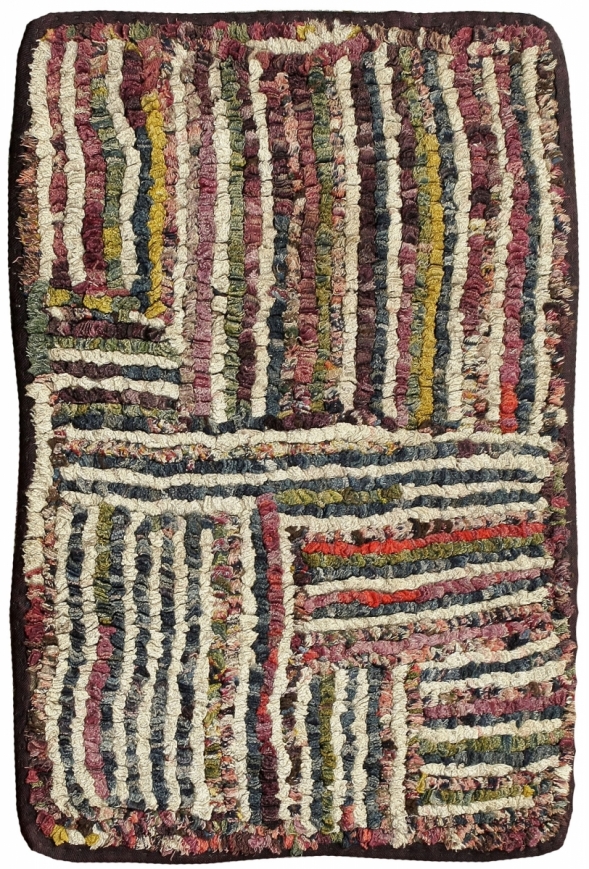 | 17.
Nambu rug
Tibet
Circa 1900
108 x 76 cm (42.5 x 30 in.)
| Knot count: | 1 H x 1 V = 1 kpsi |
| Colours: | purple, maroon, medium blue, green, light yellow, ivory (6) |
| Condition: | excellent. Full pile and all original. |
| Notes: | A rare and unusual Tibetan rug woven with the yarn obtained by unraveling nambu skirts, which are typically decorated by multicoloured stripes. The unraveled wool is arranged by colour and then hand-stitched onto an indigo-dyed cotton fabric, creating a pattern. The design here is strongly reminiscent of the pinwheel, which is a motif we see also on other types of Tibetan rugs. The visual effect is that of counterclockwise motion. This is the third example I personally ever seen for this elusive group. |
|
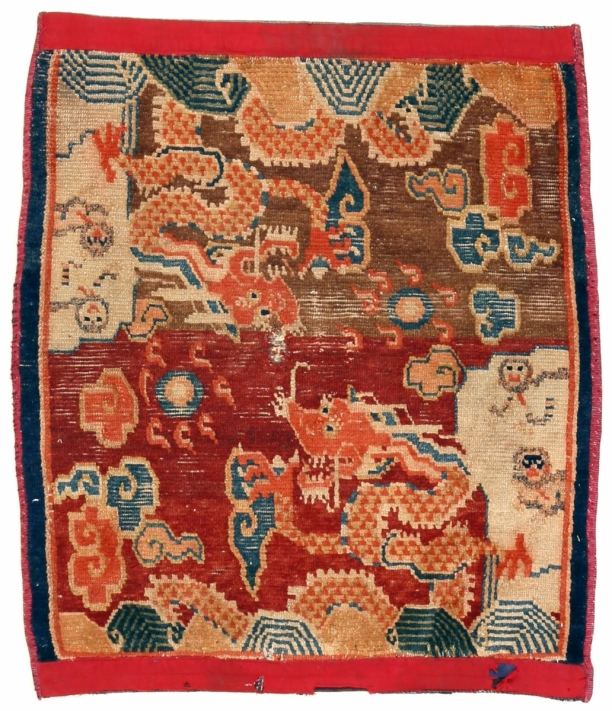 | 18.
Small rug with dragons
Tibet
Circa 1900
76 x 63 cm (30 x 25 in.)
| Knot count: | 11 H x 6 V = 66 kpsi |
| Colours: | cranberry red, strawberry red, rose, dark blue, light blue, light green, light brown, beige (8) |
| Condition: | localised areas of wear. Original sides and ends, the latter bound with red fabric. |
| Notes: | A very unusual rug depicting opposing dragons sprouting from the sacred mountain, flanked on the right by cartoon-like masked creatures. I haven’t found any comparables in the literature. The red cotton bindings at each end suggest that it might have been intended for monastic purposes. |
|
 | 19.
Tiger pelt pillow
Tibet
Circa 1850
56 x 48 cm (22 x 19 in.)
| Colours: | light yellow, black (2) |
| Condition: | complete with Ming silk brocade at both ends. Very good pile overall with scattered areas of moth damage. |
| Notes: | A very rare pillow, most probably used by a High Lama, with a tiger pelt design consisting of a pile rug joined in a cylindrical form, filled with straw and contained at both ends by a refined silk brocade from the Ming period. I am not aware of other examples of this type published in the literature. |
|
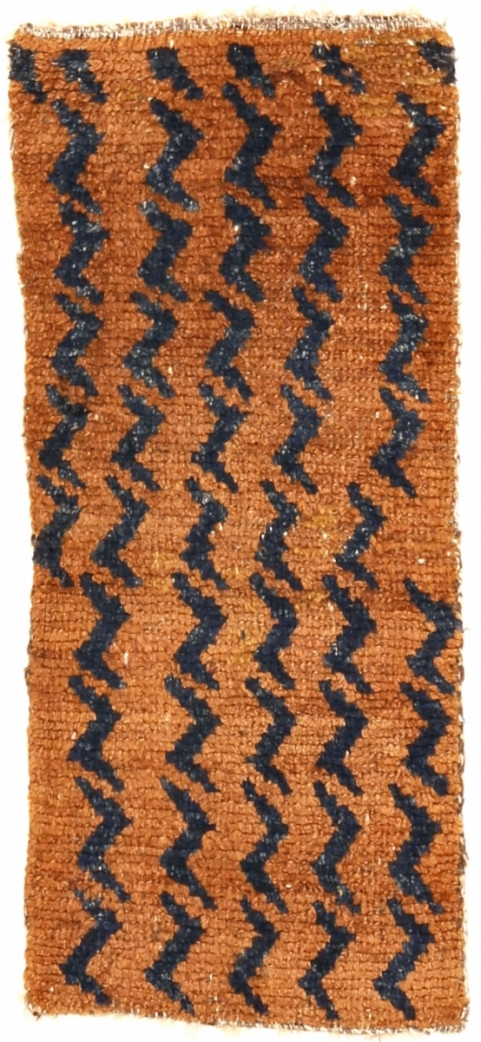 | 20.
Small tiger rug
Tibet
Circa 1880
70 x 32 cm (27.5 x 12.5 in.)
| Knot count: | 6 H x 5 V = 30 kpsi |
| Colours: | mustard yellow, dark blue (2) |
| Condition: | good pile overall. Original sides and ends. |
| Notes: | When I uncovered this piece in a Chinese private collection it was framed by a green tie-dyed fabric with the ‘pulao’ pattern. The collector then decided to remove it since (he later explained to me) this made the piece look tidier. Although it’s wider than the piece in the Piccus collection (R.P. Piccus, Sacred & Secular - The Piccus Collection of Tibetan Rugs, Chicago 2011, plate 26) it’s possible that it was originally one of those cylindral weavings used as protection against evil. Apparently it was once in the Potala Palace in Lhasa. |
|
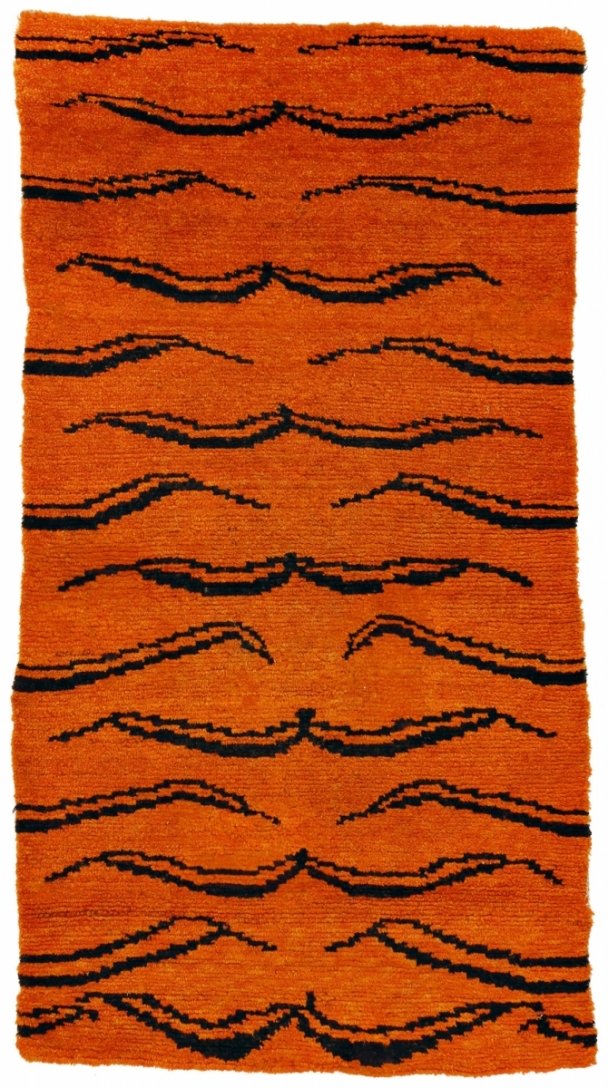 | 21.
Tiger pelt rug
Tibet
Circa 1900
154 x 85 cm (61 x 33.5 in.)
| Knot count: | 7 H x 4 V = 28 kpsi |
| Colours: | 154 x 85 cm (61 x 33.5 in.) |
| Condition: | full lush pile with original sides and ends. A few scattered rewoven areas. |
| Notes: | The tiger pelt was a symbol of high rank in Tibet, employed almost exclusively on weavings destined to the religious as well as secular upper class. Following a series of important exhibitions and publications, rugs of this type have become exceedingly rare and sought after. |
|
 | 22.
Tsukdruk panel with tiger pelt pattern
Tibet
Circa 1900
150 x 18 cm (59 x 7 in.)
| Colours: | mustard yellow, black (2) |
| Condition: | complete single panel, stitched on a black cotton backing and mounted on a wooden stretcher. One small stain half way on the left side. |
| Notes: | When I purchased this piece near the Stupa in Bodnath, Kathmandu, it was bound at each end with an ugly red fabric, the upper end having loops which suggested that it had been used as a small pillar cover in a Buddhist monastery. |
|
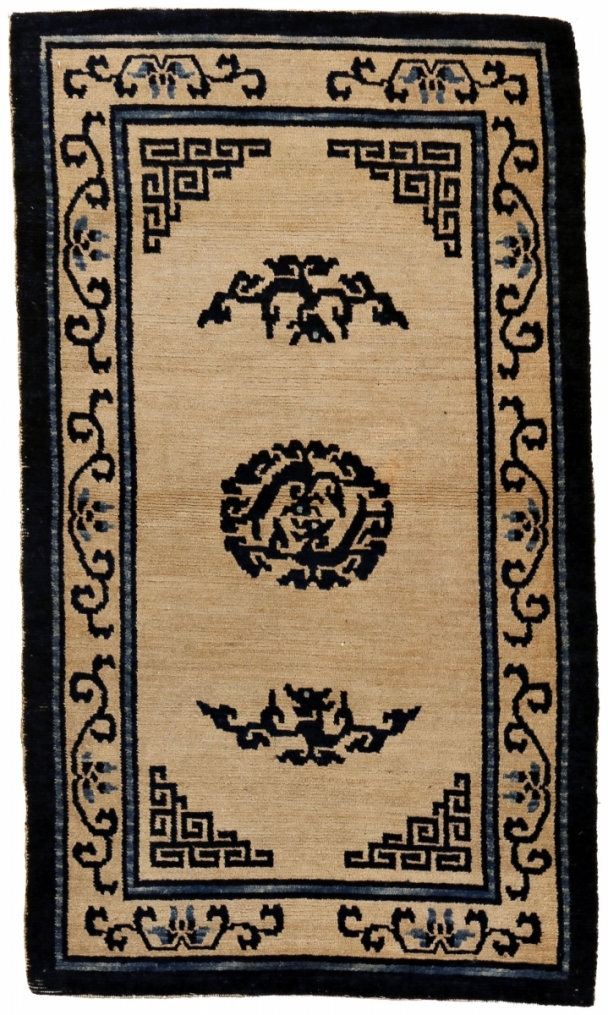 | 23.
Khaden with archaic dragons
Tibet
Circa 1900
158 x 91 cm (62 x 36 in.)
| Knot count: | 9 H x 6 V = 54 kpsi |
| Colours: | dark blue, medium blue, light blue, camel (4) |
| Condition: | excellent. Full pile with original sides and ends. |
| Notes: | The pattern here is taken verbatim from Ningxia rugs of the Kangxi period (1662-1722). It is possible that the weaver was copying the design from a period Chinese rug used in a monastery. Hunted at the Stupa in Bodnath, Kathmandu. |
|
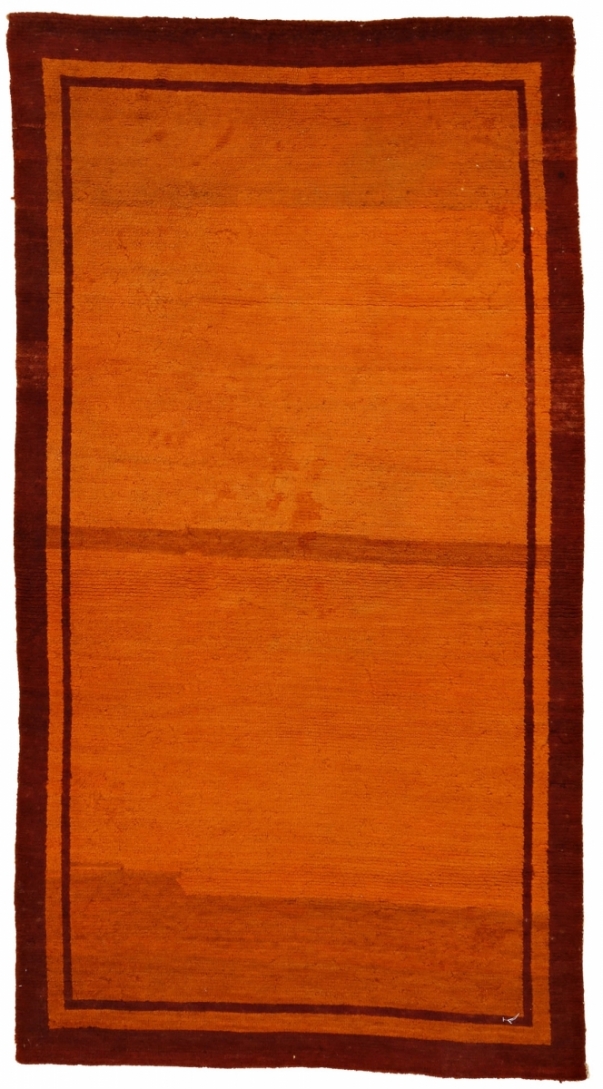 | 24.
Khaden with open field
Tibet
Circa 1900
156 x 84 cm (61.5 x 33 in.)
| Knot count: | 9 H x 6 V = 54 kpsi |
| Colours: | orange, maroon (2) |
| Condition: | good pile overall. Minor areas of moth damage. Original sides and ends. |
| Notes: | Judging from the copious amount of orange it is fair to assume that it was intended as a sitting rug for monastic use. Also hunted at the Stupa in Bodnath, Kathmandu. |
|
 | 25.
Yak collar with rice grain pattern
Tibet
Circa 1900
63 x 12 cm (25 x 5 in.)
| Knot count: | 9 H x 6 V = 54 kpsi |
| Colours: | pink, dark blue, dark brown, ivory (4) |
| Condition: | very good pile overall with a tiny spot of wear at one end due to friction with the yak’s neck. |
| Notes: | A very unusual pile trapping used as an ornament for the yak, embellished by an allover pattern of rice grains, a design taken from the repertoire of antique Ningxia carpets. |
|
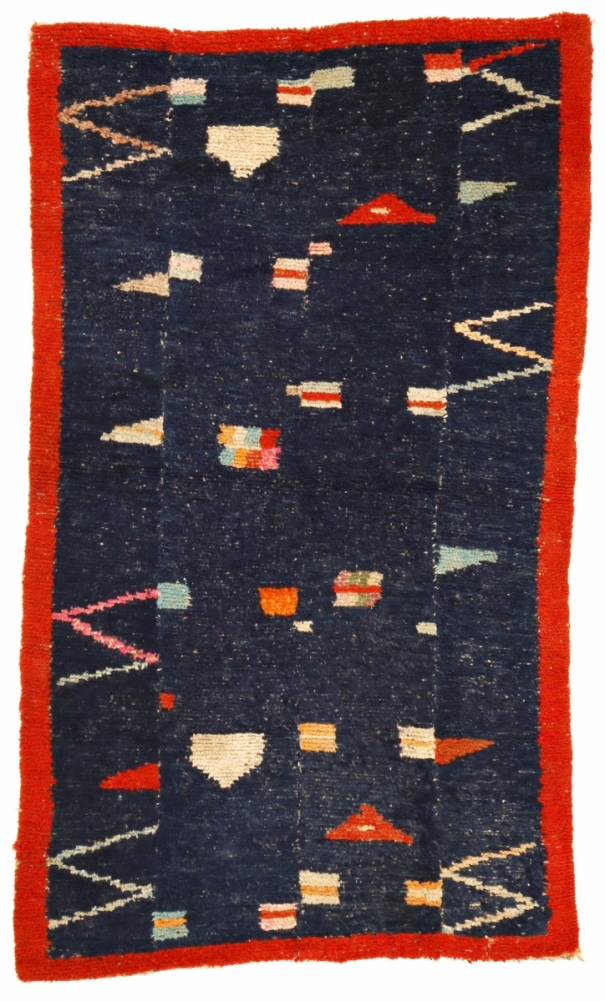 | 26.
Tsukdruk with nambu pattern
Tibet
Circa 1930
149 x 79 cm (59 x 31 in.)
| Knot count: | 5 H x 6 V = 30 kpsi |
| Colours: | dark blue, turquoise, light blue, red, orange, pink, green, camel, ivory (9) |
| Condition: | good pile overall, with original sides and ends. |
| Notes: | Rugs woven in this particular type of slip-loop technique follow a tradition which dates to the earliest phase of pile weaving. Each of the four panels is woven individually and then are hand-stitched together. The handle of tsukdruk rugs is extremely supple, indicating that they were not used for the floor but as blankets or covers of some sort. Here the indigo background is embellished by various motifs we often encounter on flatwoven nambu textiles, which were used as garments of prestige by Tibetan women. |
|
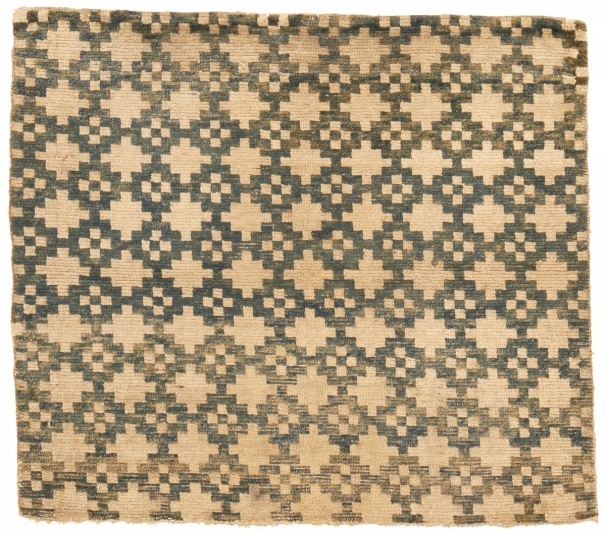 | 27.
Meditation mat with stepped diamonds
Tibet
Circa 1880
95 x 85 cm (37.5 x 33.5 in.)
| Knot count: | 9 H x 6 V = 54 kpsi |
| Colours: | jade green, ivory (2) |
| Condition: | good pile overall with a small localised area of small wear towards the bottom. Original flatwoven end at the top with small remnants at the bottom. |
| Notes: | A finely woven, early example distinguished by a refined jade green background. Rugs of this vintage have virtually disappeared from the market. |
|
 | 28.
Wangden rug with red open field
Tibet
Circa 1900
140 x 76 cm (55 x 30 in.)
| Condition: | good pile overall. Original sides and ends. |
| Notes: | A fairly unique example of monochrome Wangden rug, the latter being distinguished by the characteristic warp-face back. Typical for the group is the use of lanolin-rich wool which imparts a special sparkle to the red. |
| for back detail click... here |
|
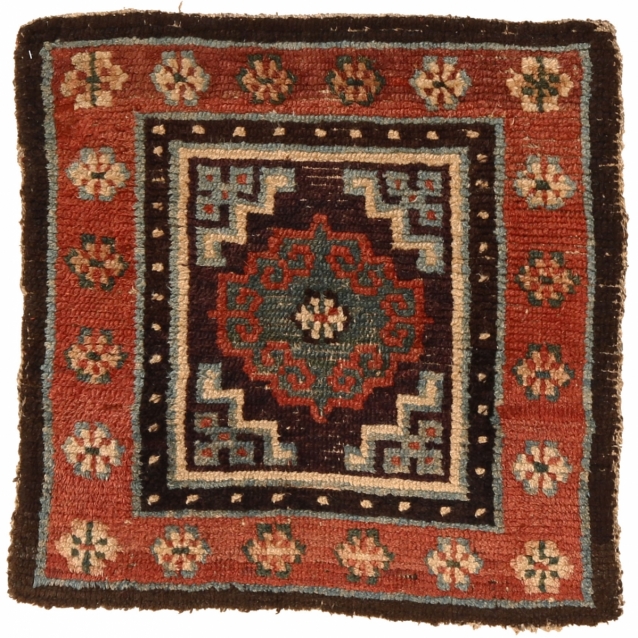 | 29.
Meditation mat with archaic mandala
Tibet
Circa 1850
62 x 61 cm (24.5 x 24 in.)
| Knot count: | 6 H x 4 V = 24 kpsi |
| Colours: | purple, coral, green, light blue, tan, dark brown, ivory (7) |
| Condition: | good pile overall with minuscule areas of very slight wear. Original sides and ends. |
| Notes: | Tibetan rugs with thick squarish knots and a brilliant palette are considered among the earliest, often referred to in Tibet as Gyantse. Here we see a centralised green archaic mandala on a purple background surrounded by stylised cloudbands. The silky Himalayan wool emphasizes the quasi-sculptural quality of the composition. |
|
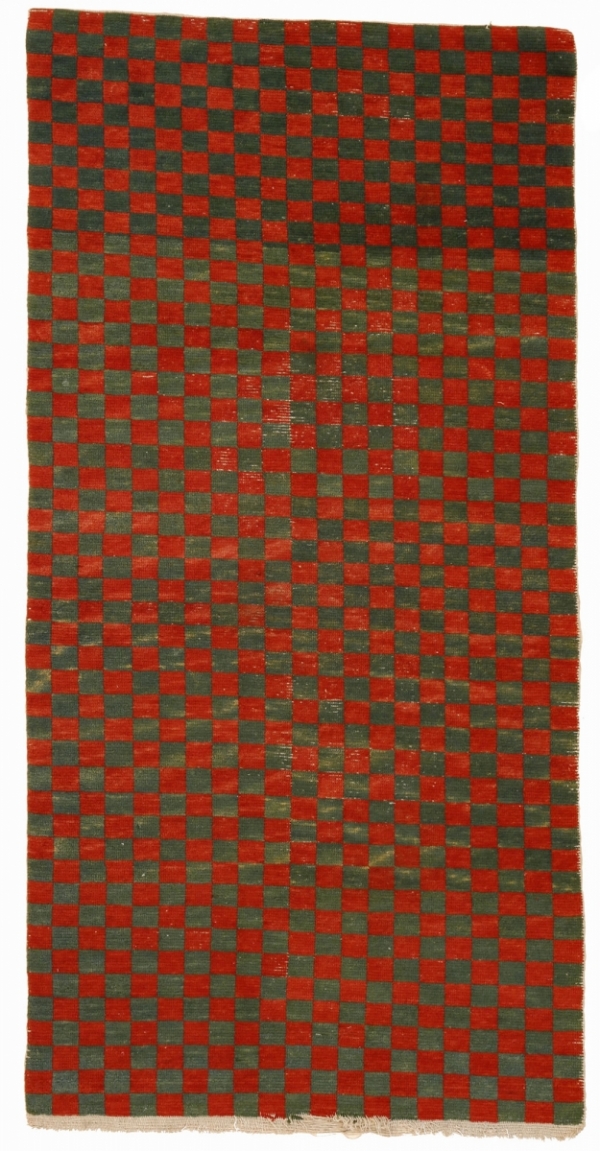 | 30.
Khaden with chequerboard pattern
Tibet
Circa 1880
167 x 83 cm (66 x 33 in.)
| Knot count: | 10 H x 6 V = 60 kpsi |
| Condition: | good pile overall, with a minuscule area of slight wear towards the center. Original sides and ends. |
| Notes: | A trophy from my early hunting days in Tibet, this fine chequerboard rug belongs to the earliest group for this type, now almost extinct. The wool is as soft as cashmere and the colours are rich and fully saturated. It adorned for many years the living room of my bachelor’s pad. |
|
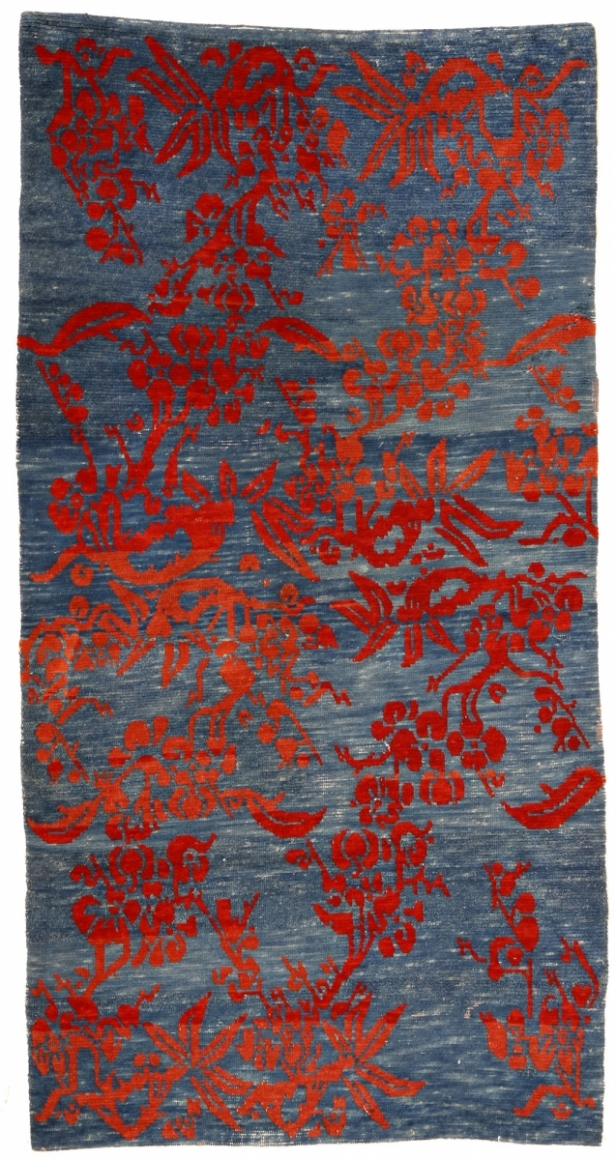 | 31.
Khaden with scrolling tendrils
Tibet
Circa 1880
172 x 90 (67.5 x 35.5 in.)
| Knot count: | 10 H x 6 V = 60 kpsi |
| Colours: | light blue, red (2) |
| Condition: | excellent. An almost invisible spot of minor wear. |
| Notes: | Like the preceding example it belongs to a class of very fine Tibetan weavings representative of the first crop, soon to be picked by all us hungry hunters. It has been in my private collection for many years. |
|
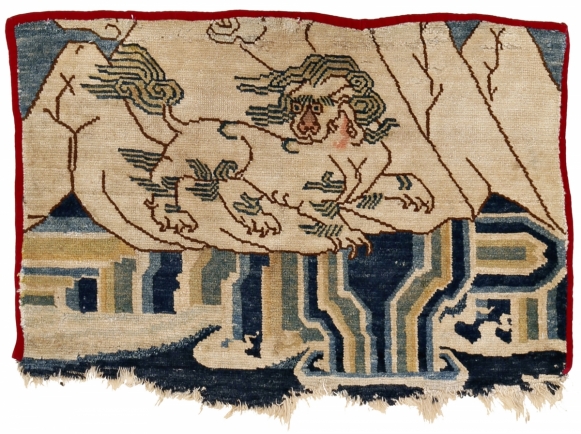 | 32.
Rug fragment with snow lion
Tibet
Circa 1880
80 x 56 cm (31.5 x 22 in.)
| Knot count: | 10 H x 8 V = 80 kpsi |
| Colours: | dark blue, light blue, green, light pink, light yellow, brown, ivory (7) |
| Condition: | fragmentary, needs conservation at lower end, areas of moth damage at upper end. otherwise good pile overall. Sides and upper end originally conserved with a red velvet cloth. |
| Notes: | A very archaic looking fragment dominated by a snow lion, the deity of the Tibetan mountains, symbol of boundless energy and fearlessness. |
| Published: | D.Miller, Auspicious Carpets - Tibetan Rugs and Textiles, 2009, p. 113. |
|
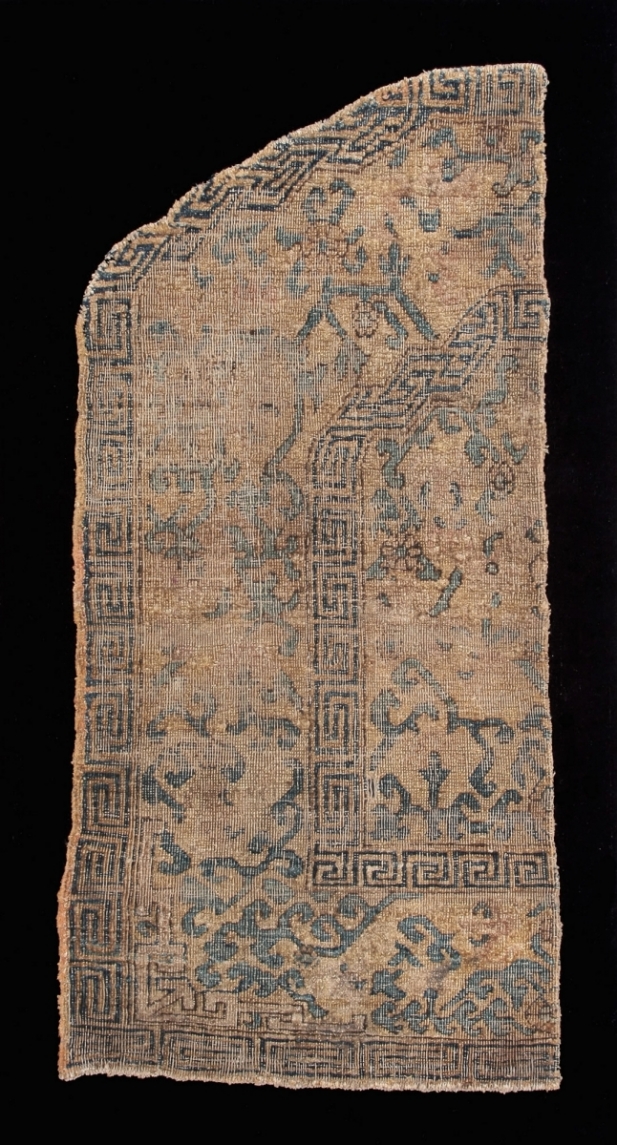 | 33.
Silk throne cover fragment
Kashgar
East Turkestan
Circa 1700
81 x 43 cm (32 x 17 cm)
| Knot count: | 16 H x 14 V = 224 kpsi |
| Colours: | medium blue, light blue, gold yellow, brown (4) |
| Condition: | fragment of the left half with areas of wear. Conserved on a black cotton fabric and mounted on a wooden stretcher. |
| Notes: | This fragment belongs to a specific group of twelve silk Kashgar throne covers, all with a similar design, palette and extremely fine knotting. Among the group one in the Victoria & Albert Museum in London and two in the Metropolitan Museum in New York (see E. Herrmann, Asiatische Teppich-und Textilkunst, Munich, vol. 2 plate 73 and vol. 5 plate 107). The delicate tracery is compounded by a choice of colours that speaks of great age and nobility. |
|
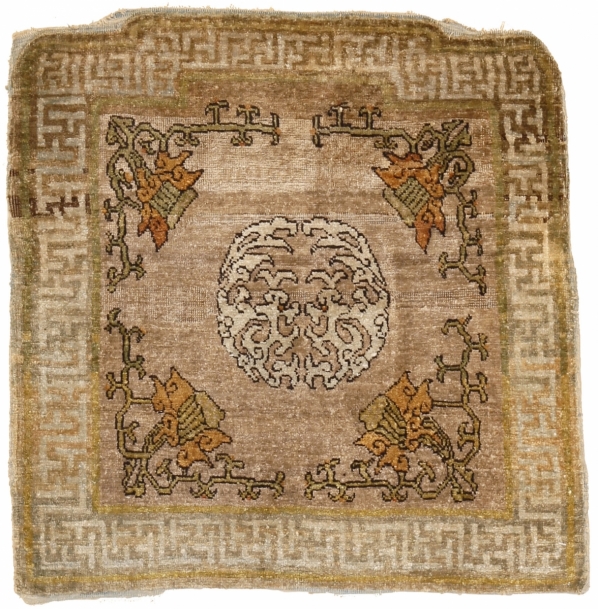 | 34.
Silk throne cover with opposing dragons and lotus flowers
Yarkand
East Turkestan
Circa 1830
69 x 66 cm (27 x 26 in.)
| Knot count: | 11 H x 10 V = 110 kpsi |
| Colours: | taupe, aqua, bronze, light green, medium green, dark brown (6) |
| Condition: | good pile overall with original sides and ends. |
| Notes: | A true gem of a weaving, with that perfect balance of colour and design that makes me love rugs so much. A central roundel composed of affronting (or kissing?) dragons, surrounded by four delicate lotus flowers with outstretching leafy stems. The silk texture gives a silvery sparkle to the refined polychromy. What more is there to desire? |
|
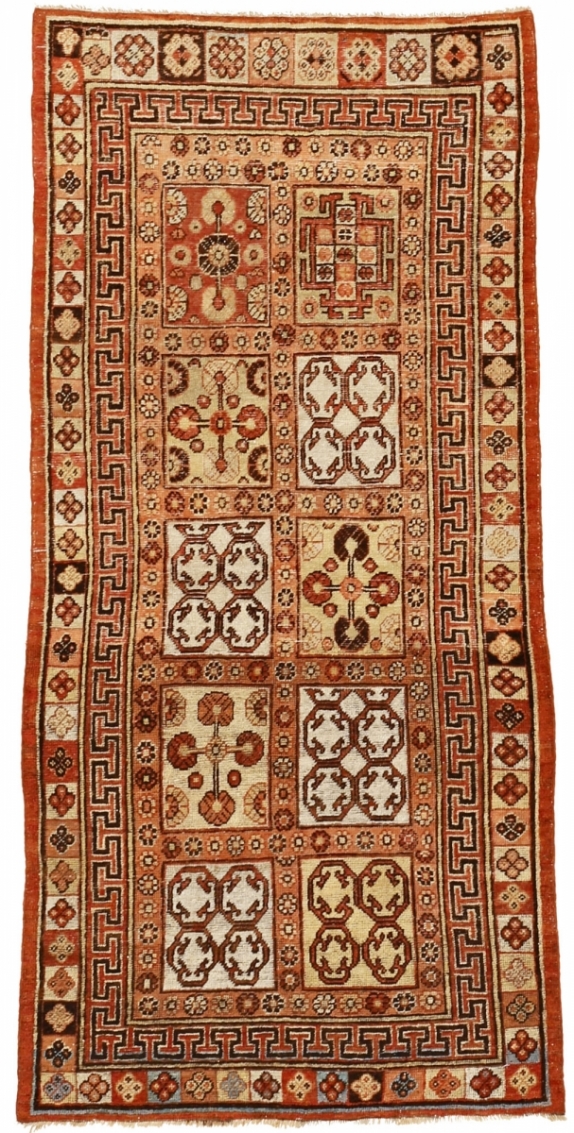 | 35.
Rug with garden design
Khotan
East Turkestan
Circa 1830
206 x 96 cm (81 x 38 in.)
| Knot count: | 9 H x 8 V = 72 kpsi |
| Colours: | brick red, coral pink, light blue, light yellow, dark brown, ivory (6) |
| Condition: | medium to low pile. Scattered areas of repiling. Rewoven upper guard stripe. |
| Notes: | An unusual pattern for Khotans, consisting of two rows of five compartments floating on a coral pink background punctuated by multicoloured rosettes. Five compartments contain the longevity motif, four have a geometric network of palmettes and one a fairly unique hooked element. The overall arrangement of the design reminds me of Safavid garden carpets. |
|
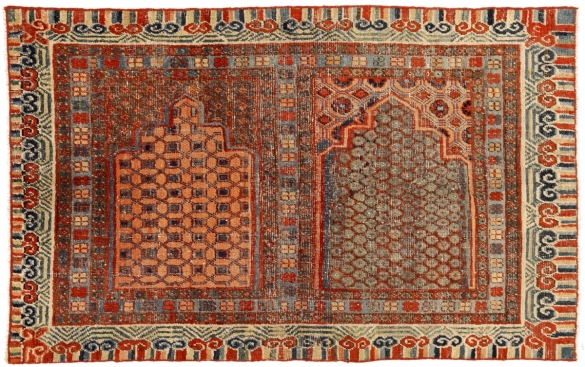 | 36.
Rug with two niches
Yarkand
East Turkestan
Circa 1800
160 x 100 cm (63 x 39.5 in.)
| Knot count: | 10 H x 6 V = 60 kpsi |
| Colours: | brick red, coral pink, pale rose, dark blue, medium blue, light blue, blue green, light green, pale green, dark brown, ivory (11) |
| Condition: | medium to low pile, with corroded dark browns. Minor areas of repiling. |
| Notes: | I don’t know of any other east Turkestan rug with only two niches, displayed here in a sort of yin yang. The outstanding palette, consisting of three shades of red, blue and green, is used with the mastery of an experienced weaver, imparting a translucency similar to Medieval glass mosaics. All my fellow hunters will agree that early east Turkestan weavings are among the hardest one to find. This certainly belongs to the pinnacle of this rare family of rugs. |
|
| | |
| For more information please visit... www.albertolevi.com | |
| and visit our rugrabbit.com profile.... http://www.rugrabbit.com/profile/471 | |












































